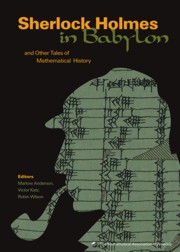Book contents
- Frontmatter
- Introduction
- Contents
- Ancient Mathematics
- Medieval and Renaissance Mathematics
- The Seventeenth Century
- The Eighteenth Century
- Foreword
- Brook Taylor and the Mathematical Theory of Linear Perspective
- Was Newton's Calculus a Dead End? The Continental Influence of Maclaurin's Treatise of Fluxions
- Discussion of Fluxions: from Berkeley to Woodhouse
- The Bernoullis and the Harmonic Series
- Leonhard Euler 1707–1783
- The Number e
- Euler's Vision of a General Partial Differential Calculus for a Generalized Kind of Function
- Euler and the Fundamental Theorem of Algebra
- Euler and Differentials
- Euler and Quadratic Reciprocity
- Afterword
- Index
- About the Editors
Foreword
from The Eighteenth Century
- Frontmatter
- Introduction
- Contents
- Ancient Mathematics
- Medieval and Renaissance Mathematics
- The Seventeenth Century
- The Eighteenth Century
- Foreword
- Brook Taylor and the Mathematical Theory of Linear Perspective
- Was Newton's Calculus a Dead End? The Continental Influence of Maclaurin's Treatise of Fluxions
- Discussion of Fluxions: from Berkeley to Woodhouse
- The Bernoullis and the Harmonic Series
- Leonhard Euler 1707–1783
- The Number e
- Euler's Vision of a General Partial Differential Calculus for a Generalized Kind of Function
- Euler and the Fundamental Theorem of Algebra
- Euler and Differentials
- Euler and Quadratic Reciprocity
- Afterword
- Index
- About the Editors
Summary
Newton and Leibniz invented calculus in the late seventeenth century. The following century saw its continued development, so many of the articles in this section deal with aspects of the calculus. But since the towering figure in the eighteenth century is Leonhard Euler, much of this section deals with aspects of his work as well, both in analysis and in number theory.
The opening article of this section, however, deals with neither of these subjects. Although Brook Taylor is best known for his 1715 work Methodus Incrementorum Directa et Inversa, in which he discusses the Taylor series expansion of a function, in that same year he also published a book entitled Linear Perspective, in which he teaches methods for artists to represent three-dimensional objects on two-dimensional canvases. This work went through several editions and was translated into French and Italian, but in general proved too abstract for the artists to whom it was addressed. P. S. Jones analyzes several interesting ideas in the book, especially those that appeared in the first edition but were removed in later editions.
Evidently, one of the reasons Taylor's work was not as well received on the Continent as it might have been was that it was caught in the dispute between the followers of Newton and those of Leibniz on the origins of the calculus. Another important British author who was caught in that controversy was Colin Maclaurin.
- Type
- Chapter
- Information
- Sherlock Holmes in BabylonAnd Other Tales of Mathematical History, pp. 301 - 302Publisher: Mathematical Association of AmericaPrint publication year: 2003

